National Space Trophy Winners
Click on the recipient's name to read their profile.
Profiles of National Space Trophy Winners
2025 Winner: Pamela Melroy

NASA Photo
Pamela Melroy, NASA Deputy Administrator Melroy, will receive the 2025 National Space Trophy for being "a trailblazer who has inspired future generations to pursue careers in STEM" and having "a long and distinguished career in aviation and space." Melroy holds a bachelor's degree in physics and astronomy from Wellesley College and a master's degree in Earth and planetary sciences from the Massachusetts Institute of Technology. Melroy was commissioned by the Air Force ROTC program in 1983. She served as a co-pilot, aircraft commander, and instructor pilot flying the KC-10 at Barksdale Air Force Base in Louisiana. She is a veteran of Operation Desert Shield/Storm and Operation Just Cause with over 200 hours of combat and combat support hours. She went on to attend the Air Force Test Pilot School at Edwards Air Force Base in 1991 where she served as a test pilot on the C-17 Combined Test Force. Melroy has logged over 6,000 hours of flight time in more than 50 aircraft. As one of only two women to command a shuttle, Melroy has made three trips to space, totaling over 38 days. Melroy shifted to the private sector in 2009 when she joined Lockheed Martin as Deputy Program Manager of Orion Space Exploration Initiatives. She went on to serve in leadership roles as the FAA, DARPA, Nova Systems Pty, Australia, and the National Space Council's User Advisory Group. Melroy is the recipient of numerous honors including the NASA Distinguished Service Medal, the Secretary of Defense Medal for Outstanding Public Service, and the AIAA Public Service Medal. She was inducted into the Astronaut Hall of Fame in May 2020 and is an Associate Fellow for the American Institute of Aeronautics and Astronautics.
See
2025 winner press release for a longer profile.
Return to the top
2024 Winner: Christopher Scolese

Portrait by Pat Rawlings
Christopher Scolese, Director of the National Reconnaissance Office (NRO), received the 2024 National Space Trophy for his "demonstrated technical brilliance, exemplary administrative skills, and outstanding leadership during a 32-year NASA career, culminating with 7 years as [Goddard Space Flight Center] Director and currently as the director of the NRO." Dr. Scolese's career began in 1987 at NASA's Goddard Space Flight Center, where he served as Earth Observing System (EOS) Systems Manager, EOS Terra Project Manager, EOS Program Manager, and Deputy Director of Flight Programs and Projects for Earth Science. In 2001, he was assigned to NASA's Washington, D.C., office, where he served in a variety of positions beginning with Deputy Associate Administrator of Space Science. In this role, Dr. Scolese managed the oversight of NASA's Space Science Flight Program, technology development and contract management of the Jet Propulsion Laboratory. In 2004, he returned to Goddard Space Flight Center as Deputy Director before shifting back to NASA headquarters as Chief Engineer in 2005. In 2007, he was appointed NASA's Associate Administrator, overseeing the agency's programmatic and technical efforts. Between January and July 2009, Dr. Scolese served as NASA's Acting Administrator. Dr. Scolese is the recipient of numerous honors including the 2018 AIAA Von Karman Award, the Presidential Rank Award of Meritorious Executive, the NASA Distinguished Leadership Medal, Goddard Outstanding Leadership, and two NASA Outstanding Leadership Medals. He is a fellow of the American Institute of Aeronautics and Astronautics and a member of the Institute of Electrical and Electronics Engineers. Dr. Scolese holds a Bachelor of Sciences degree in electrical and computer engineering from the University of New York at Buffalo; a master's degree in electrical and computer engineering from George Washington University; and a Ph.D. in systems engineering from George Washington University. See
2024 winner press release for a longer profile.
Return to the top
2023 Winner: Gwynne Shotwell
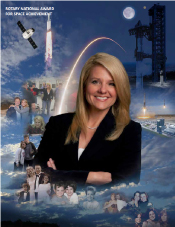
Portrait by Pat Rawlings
Gwynne Shotwell, President and COO of SpaceX, received the 2023 National Space Trophy for being "a strong leader, engineer, and trusted partner to NASA, the Air Force, the National Security community, and commercial customers." Shotwell joined SpaceX in 2002 as its first Vice President of Business Development. One of the company's first dozen employees, she was initially responsible for selling launches to commercial and government customers before the company had operational rockets. Shotwell became President and Chief Operating Officer of SpaceX in 2008. She is responsible for day-to-day operations, including production, launch, sales, mission management, finance, and management of all customer and strategic relations to support company growth. As President, she leads more than 10,000 employees. Shotwell served on the California Space Authority Board of Directors and its executive committee from 2004 to 2011. In 2014 she was appointed to the Export-Import Bank of the United States Advisory Committee and the FAA Management Advisory Council. Shotwell joined the Polaris Industries board of directors in 2019. She has received the World Technology Award for Individual Achievement in Space, was inducted into the Women in Technology International Hall of Fame, and is an elected fellow of the American Institute of Aeronautics and Astronautics. Through leadership in both corporate and external programs, Ms. Shotwell has helped raise over $1.4 million for STEM education programs reaching thousands of students nationwide. She has authored dozens of papers on a variety of space-related subjects. See
2023 winner press release for a longer profile.
Return to the top
2020 Winner: Ellen Ochoa (Awarded in 2022)
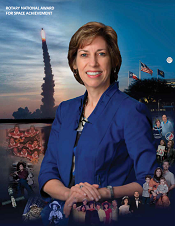
Portrait by Pat Rawlings
Ellen Ochoa, Retired Johnson Space Center Director, received the 2020 National Space Trophy for distinguishing "herself as a champion for space exploration and scientific discovery through her dedicated service to NASA and to our Nation." Ochoa earned her Bachelor of Science degree in Physics from San Diego State University in 1980 and a Master of Science degree and Doctorate in Electrical Engineering from Stanford University in 1981 and 1985. She has earned numerous accolades during her 30-year career including NASA's Distinguished Service Medal and four Space Flight Medals. She is a Fellow of the American Association for the Advancement of Science (AAAS), the American Institute for Aeronautics and Astronautics (AIAA), the National Academy of Inventors (NAI), and the Optical Society of America (OSA), and she has been inducted into the Astronaut Hall of Fame, the California Hall of Fame and the International Air & Space Hall of Fame. Ochoa began her three-decade long career as a research engineer at Sandia National Laboratories and NASA Ames Research Center. She has three patents in the area of optical information processing and numerous publications in technical journals. Selected to join the Astronaut Corps in 1990, she became the first female Hispanic astronaut and flew on four space shuttle missions. Ochoa was appointed as NASA Johnnson Space Center's (JSC) deputy director of flight crew operations in 2002 before being promoted to director in 2006. In 2007, she was named deputy director of JSC where she stayed until her appointment as JSC's 11th director (and JSC's first Hispanic director) in 2013. Ochoa retired from the federal government in 2018 and now serves as vice chair for the National Science Board, among other activities. See
2020 winner press release for a longer profile.
Return to the top
2019 Winner: David Thompson
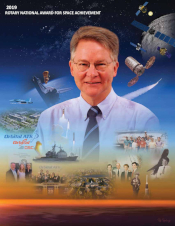
Portrait by Pat Rawlings
David Thompson, Retired President and CEO of Orbital ATK, received the 2019 National Space Trophy for his "four decades of outstanding leadership and pioneering innovations in the development and operation of launch vehicles and satellite systems, which have transformed scientific, exploratory, commercial and defense applications of space." Thompson earned his B.S. in Aeronautics and Astronautics from Massachusetts Institute of Technology, a M.S. in Aeronautics from Caltech, and an MBA from Harvard Business School. He is an Honorary Fellow of the American Institute of Aeronautics and Astronautics, a Fellow of the American Astronautical Society and the Royal Aeronautical Society, and a member of the U.S. National Academy of Engineering and the International Academy of Astronautics. Thompson began his four-decade long career in space technology as a young engineer at NASA's Marshall Space Flight Center in 1978, following summer internships during college and graduate school at the Jet Propulsion Laboratory, Johnson Space Center and Langley Research Center. His career as a space entrepreneur and business leader accelerated in the early 1980's when he and two Harvard Business School classmates founded Orbital Sciences Corp., a startup that focused on the development of space systems for commercial, military and scientific customers. Over the subsequent 35 years, Thompson led his company from its infancy to Fortune 500 status, reaching more than $5 billion in annual revenue and employing nearly 15,000 people in 2018. As one of the world's first commercial space enterprises, Orbital pioneered the investment of private capital for space systems development and manufacturing in the 1980's and 1990's. Under Thompson's leadership, Orbital expanded beyond its original business of research and manufacturing into providing space-based services in the 1990's and 2000's. See
2019 winner press release for a longer profile.
Return to the top
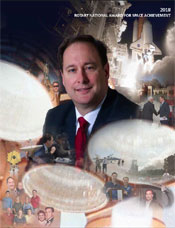
Portrait by Pat Rawlings
Robert Lightfoot, NASA Acting Administrator, received the 2018 National Space Trophy for his continued extraordinary accomplishments towards achieving NASA's vision and mission, sustaining America's leadership in space, and pushing the frontiers of science, discovery, and exploration. Lightfoot earned a bachelor's degree in mechanical engineering from the University of Alabama in 1986. His career with NASA began in 1989 at the Marshall Space Flight Center where he started as a test engineer and program manager. In 1999 he joined the Stennis Space Center in Mississippi where he was later named Propulsion Test Director in 2002. In 2003, following the Columbia accident, Lightfoot's proven track record led him to Washington, DC where he was named Assistant Associate Administrator for the Space Shuttle Program. Lightfoot transitioned back to Marshall in 2005 as Manager of the Space Shuttle Propulsion Office. In 2007 he transitioned, first as Deputy Director and in 2009 to MSFC Center Director. In 2012, Lightfoot accepted the position as NASA's Associate Administrator, the agency's highest ranking civil servant position, responsible for the day to day operations of the Agency's aeronautics, science, technology, and human spaceflight efforts. Lightfoot became NASA's Acting Administrator in January of 2017 and is now the longest serving Acting Administrator in NASA's history. He has gained significant White House engagement for the importance of a strong space program - including the signing of the NASA Transition Authorization Act of 2017. See
2018 winner press release for a longer profile.
Return to the top
2017 Winner: John Grunsfeld
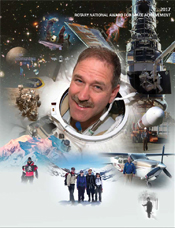
Portrait by Pat Rawlings
John M. Grunsfeld, NASA astronaut on STS-67, STS-81, STS-103, STS-109, and STS-125, and former Associate Administrator of the Science Mission Directorate at NASA Headquarters in Washington D.C., received the 2017 National Space Trophy for his contributions to science and space exploration through his unique experience as an astronaut, a teacher, scientist, and senior leader at NASA. Grunsfeld earned his bachelor of science degree in physics from the Massachusetts Institute of Technology in 1980. He went on to earn a master of science degree in 1984 and a doctor of philosophy degree in physics in 1988 from the University of Chicago. After serving as a Senior Research Fellow at the California Institute of Technology from 1989-1992, he was selected by NASA to join the astronaut training program in March of 1992. Affectionately known as the "Hubble Repairman", Grunsfeld's contributions have extended well beyond his missions to space. In 2010, he left NASA to take on a role as Deputy Director of the Space Telescope Science Institute in Baltimore. It was here that Grunsfeld helped prepare the institute for their joint efforts with NASA to develop the James Webb Telescope which will be launched in 2018. After returning to NASA in 2012 as Associate Administrator for Science, Grunsfeld managed more than 100 missions including the Curiosity Mars rover landing, the new Horizons Pluto flyby and the Deep Space Climate Observatory. These and dozens of other projects have laid the foundation to understand how our own planet is changing while inspiring a whole new generation of explorers. See
2017 winner press release for a longer profile.
Return to the top
2016 Winner: Charles Elachi
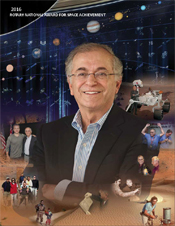
Portrait by Pat Rawlings
Charles Elachi, Director of NASA's Jet Propulsion Laboratory, received the 2016 National Space Trophy for his distinguished leadership and sustained technical achievement, which has had a profound impact on the U.S. robotic exploration of space across the late 20th and early 21st centuries. Elachi is credited with pioneering the use of radar remote sensing techniques, overseeing missions such as the Shuttle Imaging Radar series, the Magellan Imaging Radar at Venus and the Cassini Titan Radar currently studying Saturn's moon Titan. He has taught the physics of remote sensing for two decades at the California Institute of Technology. As a research scientist, he has authored more than 200 publications in the fields of active microwave remote sensing, wave propagation and scattering, electromagnetic theory, lasers and integrated optics. He has been a member of the National Academy of Engineering since 1989 and has received numerous awards and medals, both in the United States and internationally. These include the NASA Exceptional Scientific Achievement Medal and Outstanding Leadership Medal, the COSPAR Nordberg Medal, the German Wernher Von Braun Award, the Nevada Medal, and the Dryden Medal. The Takeda Foundation of Japan awarded him its medal for his work in developing space radar instruments to monitor the global environment. He also has an asteroid named after him: 4116 Elachi. In 2007, U.S. News and World Report named Elachi one of America's Best Leaders. See
2016 winner press release for a longer profile.
Return to the top
2015 Winner: Robert D. Cabana
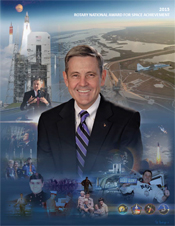
Portrait by Pat Rawlings
Colonel Robert D. Cabana, Director of the Kennedy Space Center, former NASA astronaut STS-41, STS-53, STS-65 and STS-88, and retired United States Marine Corp Colonel, received the 2015 National Space Trophy. Cabana is currently serving as the tenth director of NASA's John F. Kennedy Space Center (KSC), the primary United States (U.S.) launch site that has been used for every NASA human space flight since 1968. Cabana was inducted into the Astronaut Hall of Fame in 2008. He is the recipient of The Daughters of the American Revolution Award for the top Marine to complete naval flight training in 1976, is a Distinguished Graduate of the United States Naval Test Pilot School, and has logged over 7,000 hours in 48 different kinds of aircraft. Cabana is a Fellow in the Society of Experimental Test Pilots, an Associate Fellow in the AIAA, and he has received numerous awards and decorations, including the De La Vaulx medal by the Federation Aeronautique Internationale in 1994, the Presidential Distinguished Rank Award, and most recently he was honored with the National Space Club 2013 Kurt H. Debus Award. His personal decorations include the Defense Superior Service Medal, the Distinguished Flying Cross, the Defense Meritorious Service Medal, the Meritorious Service Medal, the National Intelligence Medal of Achievement, two NASA Distinguished Service Medals, two NASA Medals for Outstanding Leadership, two NASA Exceptional Service Medals, and four NASA Space Flight Medals. A veteran of four space flights, Cabana has logged over 910 hours in space. He served as pilot on STS-41 (October 6-10, 1990) and STS-53 (December 2-9, 1992), and was mission commander on STS-65 (July 8-23, 1994) and STS-88 (December 4-15, 1998), the first ISS assembly mission.See
2015 winner for a longer profile.
Return to the top
2014 Winner: Charles F. Bolden
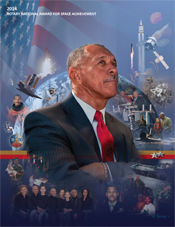
Portrait by Pat Rawlings/
Eagle Applied Sciences.
Charles F. Bolden,, retired United States Marine Corps Major and former astronaut (
STS-61-C,
STS-31,
STS-45, and
STS-60) received the 2014 National Space Trophy for his many years of dedicated service and exceptional leadership, establishing NASA's exploration architecture for the future, and also for his dedication to public service, leadership, and contributions to aeronautics and aerospace. Bolden was born in Columbia, S.C., received an appointment to the U.S. Naval Academy, earned a Bachelor of Science degree in electrical science and was commissioned as a second lieutenant in the Marine Corps. Bolden became a Naval Aviator and flew more than 100 combat missions. Bolden earned a Master of Science degree in systems management from the University of Southern California in 1977. Bolden's 34-year career with the Marine Corps also included 14 years as a member of NASA's Astronaut Office. Bolden's earned numerous military decorations. Bolden was nominated by President Barack Obama and confirmed by the U.S. Senate as the 12th Administrator of the National Aeronautics and Space Administration. He began his duties as head of the agency on July 17, 2009. As Administrator, Bolden leads a nationwide NASA team to advance the missions and goals of the U.S. space program. See
2014 winner for a longer profile.
Return to the top
2013 Winner: Kay Bailey Hutchison
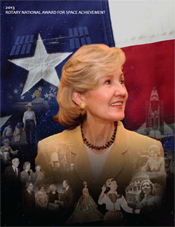
Portrait by Pat Rawlings/
Eagle Applied Sciences.
Former United States Senator Kay Bailey Hutchison (R-TX) received the 2013 National Space Trophy for her bi-partisan leadership ensuring passage of the three-year 2010 NASA Authorization Act, her dedication to education excellence, her promotion of the International Space Station Program, and her efforts to support the Orion Multi-Purpose Crew Vehicle, the Space Launch System and commercial space transportation. Kay Bailey Hutchison is a former United States Senator (R-TX) who served from June 1993 through January 2013. Originally from La Marque, Texas, Hutchison graduated from the University of Texas at Austin with a bachelor of arts degree in 1962. She went on to earn a J.D. from the University of Texas Law School. Her political career began in 1972 with her election to the Texas House of Representatives where she served until 1976. She went on to serve as vice-chairman of the National Transportation Safety Board from 1976 to 1978. She then left politics for business until 1990 when she was elected Texas State Treasurer. In 1993, Hutchison became the first woman to be elected to represent Texas in the United States Senate. She was re-elected one year later to a six-year-term and again in 2006 by an overwhelming margin. She retired from the Senate in January 2013. See
2013 winner for a longer profile.
Return to the top
2012 Winner: Michael L. Coats
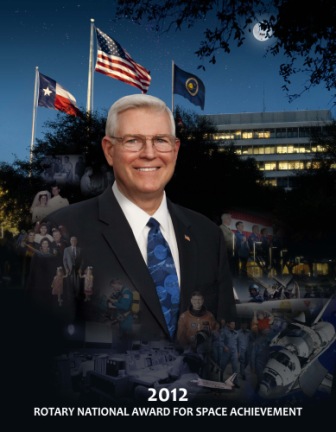
Portrait by Pat Rawlings/
Eagle Applied Sciences.
Former Astronaut Michael L. Coats received the 2012 National Space Trophy for his management as the tenth director of Johnson Space Center and his leadership to the retiring Space Shuttle program, the International Space Station program, and his advancement of the capability for human exploration and utilization of space research development. From Riverside, California, Coats earned his BS degree from the U.S. Naval Academy in 1968. His highly decorated career in the Navy included 315 combat missions in Southeast Asia. He holds a master's degree in administration of science and technology (George Washington University, 1977) and in aeronautical engineering (U.S. Naval Postgraduate School, 1979). Selected as a NASA astronaut in 1978, Coats first flew as pilot of STS 41D in 1984. He commanded STS-29 and STS-39 in 1989 and 1991, respectively. He served as acting chief of the Astronaut Office from 1989 to his departure from NASA in 1991. He was vice president of Avionics and Communications Operations for Loral Space Information Systems, vice president of Civil Space Programs for Lockheed Martin Missiles and Space, and vice president of Advanced Space Transportation for Lockheed Martin Space Systems Company. He returned to NASA in 2005 as the director for JSC. See
2012 winner for a longer profile.
Return to the top
2011 Winner: Kevin P. Chilton
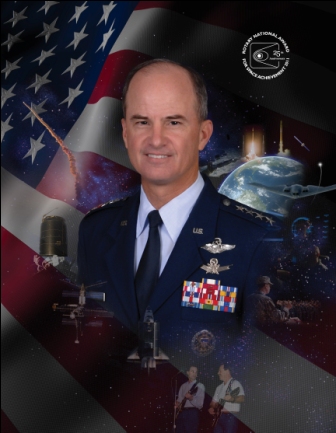
Portrait by Pat Rawlings/SAIC.
Former commander of U.S. Strategic Command, and former Space Shuttle astronaut, Kevin P. Chilton, received the 2011 National Space Trophy for his leadership in both our civilian and military space programs. Born in Los Angeles, California, Chilton graduated from the USAF Pilot Training and Test Pilot Schools and holds a BS in engineering science from the USAF Academy and an MS in mechanical engineering from Columbia University. He flew the RF-4C and F-15, and the F-4 and F-15 prior to his selection as an astronaut in 1987. Chilton piloted the maiden flight of Endeavour on STS-49 in 1992, and STS-59, the Space Radar Laboratory mission, in 1994. He commanded STS-76, the third docking mission to the Russian Space Station Mir in 1996. He then served as deputy program manager of operations for the International Space Station before leaving NASA in 1998. Chilton served on the Air Force Space Command Staff, the Air Staff, the Joint Staff, and commanded the 9th Reconnaissance Wing, 8th Air Force, Joint Functional Component Command for Space and Global Strike, and Air Force Space Command. From 2007 to 2011, Chilton commanded the U.S. Strategic Command based at Offutt AFB, Nebraska. He was responsible for the global command and control of U.S. strategic forces to meet decisive national security objectives. He retired from the USAF in 2011. See
2011 winner for a longer profile.
Return to the top
2010 Winner: William H. Gerstenmaier
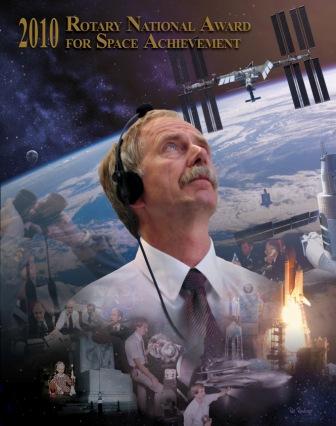
Portrait by Pat Rawlings/SAIC.
NASA Associate Administrator for Space Operations, William H. Gerstenmaier received the 2010 National Space Trophy for providing outstanding leadership and direction to the exploration of space through his contributions to the Space Shuttle and International Space Station (ISS) Programs. From Akron, Ohio, Gerstenmaier has a BS in aeronautical engineering from Purdue University (1977), a master's in mechanical engineering from the University of Toledo (1981), and has completed course work at Purdue for a PhD in dynamics and control (1992-93). He joined NASA Lewis (now Glenn) Research Center in Cleveland in 1977. He moved to the Johnson Space Center in Houston in 1980 and was a Propulsion Officer in Mission Control during the early Space Shuttle Program. Through the 1980s and 90s, Gerstenmaier held various management positions in the shuttle and space station programs and served as a branch chief in the Flight Design and Dynamics Division. He was the primary liaison to the Russian Space Agency during the 1995 to 1997 Shuttle/Mir missions and was recognized with a RNASA Stellar Award in 1997 for this work. After managing Space Shuttle Program Integration and the ISS Program, he was named NASA Associate Administrator for Space Operations in 2005 where he is responsible for oversight of NASA's Space Shuttle, ISS, space launch services programs, the astronaut crew health program, and the communication systems network. See
2010 winner for a longer profile.
Return to the top
2009 Winner: Michael D. Griffin
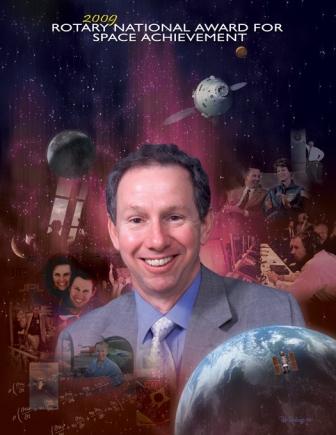
Portrait by Pat Rawlings/SAIC.
Michael D. Griffin, the 11th Administrator of NASA, received the 2009 National Space Trophy. Born in Aberdeen, Maryland, Griffin began his space career at NASA Goddard Spaceflight Center in 1974. A strong advocate for education, Griffin holds six postgraduate degrees, has taught at three different universities, and co-authored the textbook, Space Vehicle Design, (American Institute of Aeronautics and Astronautics, 1999, 2004). He was honored with the RNASA award for developing the plan to complete the International Space Station following the loss of Space Shuttle Columbia, leading the shuttle return-to-flight activities; initiating the first procurement of commercial cargo service in the agency's history; and successfully establishing the architecture for a human space exploration program. Griffin was also recognized for executive positions he held prior to selection as by President Bush in 2005. These positions include Space Department head of the Johns Hopkins University Applied Physics Lab where he oversaw the MESSENGER spacecraft to Mercury; president and COO of In-Q-Tel, where he led a private non-profit, strategic venture capital organization developing technologies for the CIA; and executive positions with Orbital Sciences Corporation, Space Industries International, and American Rocket Company; as well as service as the NASA chief engineer and associate administrator for Exploration; and the deputy for technology for the Department of Defense's Strategic Defense Initiative Organization. Griffin left NASA in 2009 and became a professor at the University of Alabama in Huntsville. See
2009 winner for a longer profile.
Return to the top
2008 Winner: Eugene A. Cernan
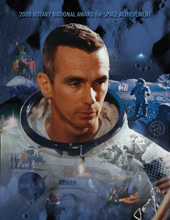
Portrait by Pat Rawlings/SAIC.
Gemini and Apollo Astronaut Captain Eugene A. Cernan was the 2008 National Space Trophy recipient. Born in Chicago, Illinois, Cernan earned a BS in Electrical Engineering from Purdue in 1956. He earned a MS in Aeronautical Engineering in 1963 from the U. S. Naval Post Graduate School in Monterey, California. Cernan was one of fourteen astronauts selected by NASA in 1963. As the pilot of Gemini 9 in 1966, Cernan became the second American to walk in space. He was lunar module pilot of Apollo 10, the "dress rehearsal" for the first lunar landing that came within 9 miles of the lunar surface in May 1969. He was commander of Apollo 17 in December 1972. This last mission to the Moon in the 20th century established records for the longest lunar landing flight; longest lunar surface extravehicular activities; largest lunar sample return; and longest time in lunar orbit. Cernan served as a senior American negotiator for the Apollo-Soyuz mission in 1974. He left the Navy and NASA in 1976. After 5 years with Coral Petroleum, he founded The Cernan Corporation in 1981 and continues to serve as President and CEO and as a consultant for various documentaries. His autobiography,
The Last Man on the Moon, was published by St. Martin's Press in 1999. See
2008 winner for a longer profile.
Return to the top
2007 Winner: Eugene F. Kranz
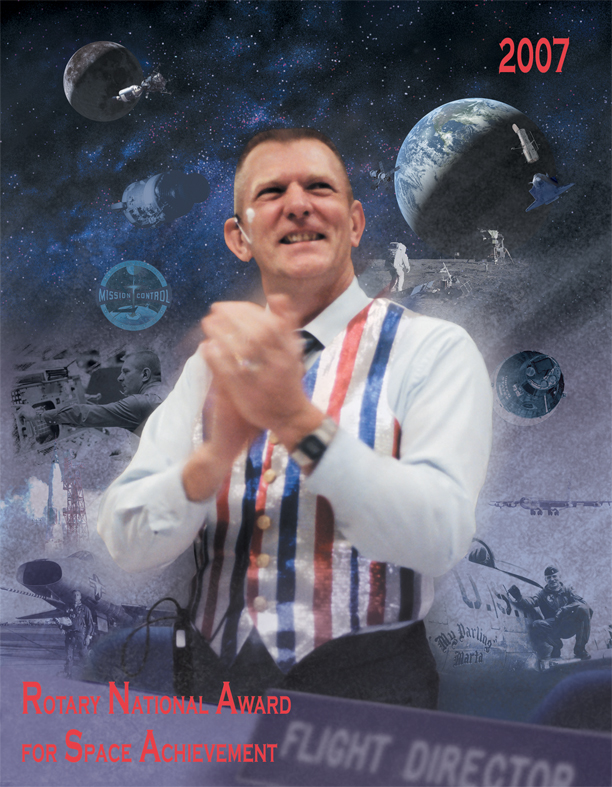
Portrait by Pat Rawlings/SAIC.
Eugene F. Kranz, former Director of Mission Operations for NASA and famed Flight Director of Apollo 13 was the winner of the 2007 National Space Trophy. Kranz was born in Toledo, Ohio. He received his BS in Aeronautical Engineering from Parks College of Saint Louis University in 1954. He was commissioned in the U.S. Air Force in 1954, and flew high-performance aircraft. After serving in Korea, he was a flight test engineer at Holloman AFB in New Mexico for McDonnell Aircraft. Kranz joined the Space Task Group at Langley Virginia in 1960 as Assistant Flight Director for Project Mercury. He served as Flight Director for all Gemini missions and many Apollo missions, including the Apollo 11 lunar landing and the successful return of the Apollo 13 crew. He was both a Flight Director and Flight Operations Director for the Skylab program. As Deputy Director of Flight Operations, and then Director of Mission Operations (starting in 1983), he was responsible for all aspects of mission design, testing, planning, training and spaceflight operations, with oversight of over 6000 employees and an annual budget of approximately $750 million. Kranz retired from NASA in March 1994. His best-selling book,
Failure is Not an Option, was published in 2000. He is a popular motivational speaker to professional, military, civic and youth groups. See
2007 winner for a longer profile.
Return to the top
2006 Winner: Eileen M. Collins
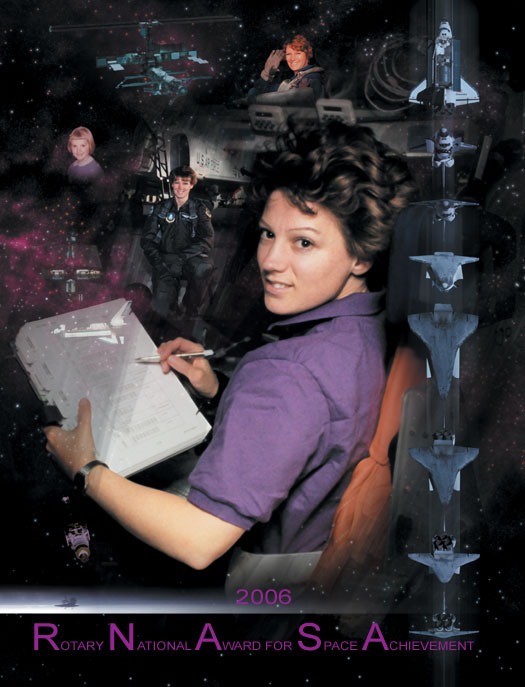
Portrait by Pat Rawlings/SAIC.
Eileen Marie Collins received the 2006 National Space Trophy as NASA's first female Space Shuttle Pilot and Commander. Originally from Elmira, New York, Collins earned her associate's degree in math/science from Corning Community College in 1976, her BA in math and economics from Syracuse University in 1978, an MS in operations research from Stanford in 1986, and a MA in space systems management from Webster University in 1989. Collins was a T-38 instructor pilot at Vance AFB in Oklahoma, and a C-141 commander and instructor at Travis AFB in California. From 1986 to 1989 she taught math at the USAF Academy in Colorado and was a T-41 instructor. She graduated from Air Force Test Pilot School at Edwards AFB in 1990 before her selection that year as a pilot astronaut. Her first flight was the first for a woman pilot. STS-63 in February 1995 performed a first rendezvous with the Russian Space Station Mir. She was pilot on STS-84 that docked with Mir in May 1997. Her third flight was STS-93, the first American space mission ever commanded by a woman. STS-93 deployed the Chandra X-ray Observatory. Collins commanded the Return-to-Flight STS-114 mission that docked to the International Space Station in July 2005, the first flight since the Columbia accident in 2003. Collins left NASA in 2006 with over 872 hours spent in space during her four missions. See
2006 winner for a longer profile.
Return to the top
2005 Winner: Glynn S. Lunney
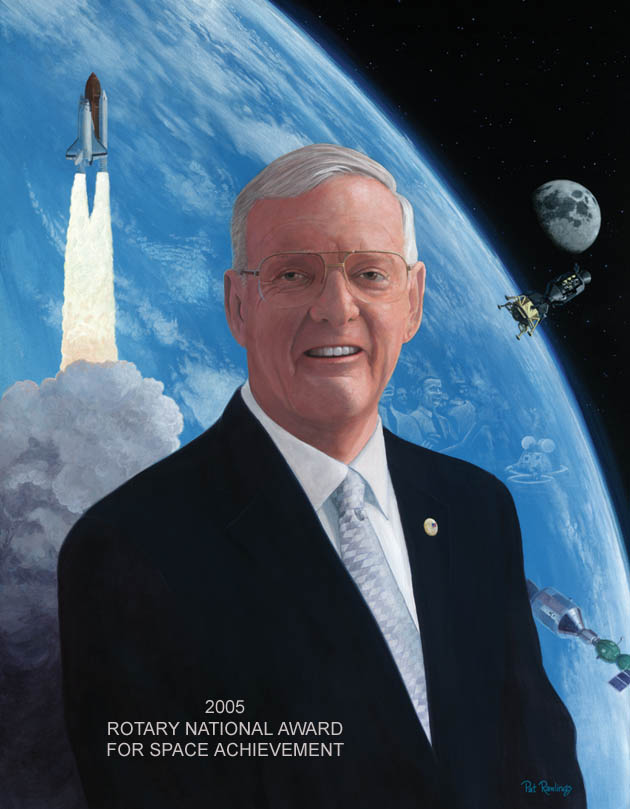
Portrait by Pat Rawlings/SAIC.
The 2005 National Space Trophy winner is former Apollo flight
director and Shuttle manager, Glynn S. Lunney. Born
in Old Forge, Pennsylvania, Lunney graduated from the University of Detroit in 1958. He worked at the Lewis (now Glenn) Research Center in Cleveland, Ohio
and transferred to Langley in Virginia in 1958. Lunney
joined the Space Task Group in 1959 and moved to Houston in 1962. He was a flight director for Gemini and Apollo and head of the Flight
Director's Office starting in 1968. He received an honorary Doctorate from the University of Scranton in 1971. In 1972, Lunney
became manager of the Apollo-Soyuz Test Project (ASTP), and
Lunney also managed the Apollo Spacecraft Office
starting in 1973. Lunney also served at NASA Headquarters in Washington, DC twice: as deputy associate administrator (AA) for Manned Space Flight from January-August of 1977, and then for six months in 1980 as acting AA for Space Transportation Operations.
In 1981, Lunney was selected manager of the Shuttle program and returned to Houston. Lunney left NASA in 1985 and became President of Rockwell's Satellite Systems Division. After a tour at Rockwell Space Systems Division in Downey, CA, he returned to Houston in 1989 to lead Rockwell's Space Operations Co. that became part of United Space Alliance (USA) in
1995. Lunney was VP and Program Manager
of USA's Space Flight Operations contract until his
retirement in 1999. See
2005 winner for a longer profile.
Return to the top
2004 Winner: Neil A. Armstrong
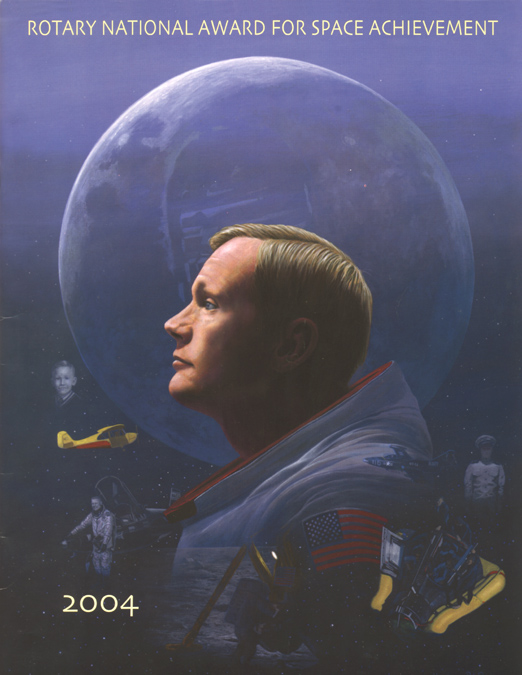
Portrait by Pat Rawlings/SAIC.
Neil A. Armstrong was the 2004 winner of the National Space Trophy for being the first explorer to land a manned spacecraft on the Moon and the first human to step on its surface. He was born in Wapakoneta, Ohio, and received his pilot's license on his 16th birthday. He went to Korea in 1950 and flew 78 combat missions. He got his engineering degree from Purdue in 1955, and his masters' from the University of Southern California in 1970. Neil Armstrong joined the predecessor of NASA at what is now Glenn Research Center in Cleveland, Ohio in 1955. He transferred to California in '58 and flew seven X-15 flights, going over Mach 5 and climbing above 200,000 feet. Selected as an astronaut in '62, he commanded Gemini 8, the first successful docking in space. He then commanded Apollo 11, fulfilling President Kennedy's goal of putting men on the moon and returning them safely to Earth. On July 20, 1969, Neil Armstrong took "one small step for a man, one giant leap for mankind." He left NASA in 1971 and taught at the University of Cincinnati until 1979. He served on the National Commission on Space in '85, and on the President's Commission on the Space Shuttle
Challenger Accident in 1986. Neil Armstrong retired from EDO Corporation in 2002, and remains the world symbol for manned space flight exploration. He passed away on August 25, 2012. See
2004 winner for a longer profile.
Return to the top
2003 Winner: Roy S. Estess
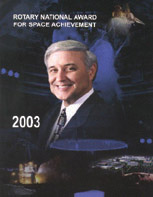
Portrait by Pat Rawlings/SAIC.
The 2004 recipient of the National Space Trophy was Roy S. Estess for his unyielding dedication, sustained leadership, and commitment to excellence in advancing America's space program. A native of Tyler Town, Mississippi, Estess earned his degree in aerospace engineering from Mississippi State University, and went to work on jet fighters at Brookley Air Force Base in Mobile, Alabama. Estess joined NASA in 1966 as a test engineer on the Saturn V at the Mississippi Test Facility, later named Stennis Space Center. He became head of the Applications Engineering Office and helped convince NASA Headquarters to test the space shuttle engines in Mississippi. From 1980 to 1989, Estess served as Deputy Director,
and became Director of Stennis in 1989. He was instrumental in establishing Stennis as the lead center for rocket propulsion testing. Estess served in Washington, DC, as Special Assistant to the from 1992 to '93, and as Acting
Director of the Johnson Space Center from Feb. 2001 to April 2002 during some of the most challenging space flights
in history. He returned to Stennis and retired in August 2002. Estess served on the RNASA Board of Advisors from 1993 until his death at age 71 in June 2010. See
2003 winner for a longer profile.
Return to the top
2002 Winner: George E. Mueller
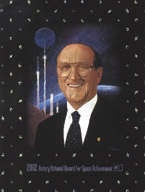
Portrait by Pat Rawlings/SAIC.
George E. Mueller, Ph.D. was chosen as the 2002 recipient of the
National Space Trophy for his contributions to the Apollo, Skylab, Space Shuttle, and commercial aerospace programs. Born in St.
Louis, Missouri, Mueller graduated from Purdue in 1940 and joined the staff at Bell Labs. In '46, he became a professor of
engineering at Ohio State University. He joined Ramo Wooldridge in '57, and worked on the Atlas, Titan, Thor, and Minuteman
ballistic missiles. He was project engineer for Pioneer 1, the United States' first successful space probe, and also for the Air
Force SPAN satellite tracking network. Mueller joined NASA as Associate Administrator for manned space flight in 1963. He
instituted the "all-up" approach to testing the Apollo and Saturn hardware which allowed NASA to achieve the lunar landing before
1970. He left NASA in '69 to join Dynamics. In 1971, he joined System Development Corporation, serving as chairman, CEO
and president. From '83 to '95, he was president of Jojoba Propagation Laboratories and also ran his own consulting firm. He was
president of the AIAA from '69 to '82, and president of the IAA from '82 to '97. In 1995, Mueller took over as CEO of Kistler
Aerospace, a firm developing a reusable commercial launch vehicle. See
2002 winner for a
longer profile.
Return to the top
2001 Winner: Tommy Holloway
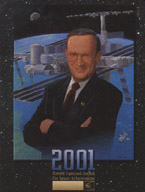
Portrait by Pat
Rawlings/SAIC.
The 2001 winner of the National Space Trophy was International Space Station Program Manager Tommy Holloway. A
native of Jasmine, Arkansas, Holloway graduated from the University of Arkansas with a degree in mechanical engineering and
joined NASA in 1963. He was a flight planner for Gemini and Apollo Flights at what is now the Johnson Space Center. He served as
a flight director for early Shuttle flights and became chief of the Flight Directors' Office in 1984, where he led an
investigation into flight operations after the Challenger accident. In 1989, he was named assistant director for the Space
Shuttle Program and then served as Deputy Manager for Program Integration. He then became Director of the Phase I Program of
Shuttle-Mir dockings before being named Space Shuttle program manager in 1995. As shuttle manager, he met his top 3 goals: fly
safely, meet the schedule, and reduce costs. In 1999, Holloway was named space station manager, responsible for a civil
service and contractor workforce of 20,000 people and a budget of $2.3 billion dollars. He retired in 2002. See
2001 winner for a longer profile.
Return to the top
2000 Winner: John W. Young
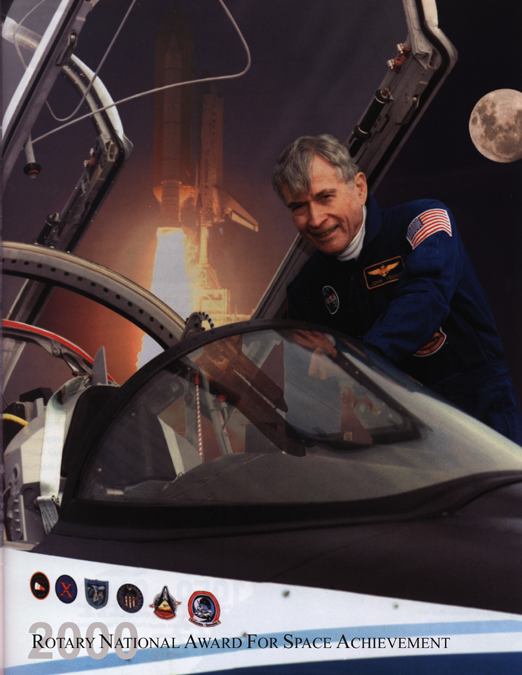
Painting by Robert McCall,
McCall Studios Inc.
The only astronaut to fly Gemini, Apollo, and
Shuttle projects, John W. Young was the recipient of the RNASA
Corona Award in
1997, and the National Space Trophy in 2000. He was born in San Francisco, and graduated from high school in Orlando. John
Young earned his degree from Georgia Tech in '52 and became a Navy test pilot. In 1962, he set the world time-to-climb record in
an F-4 Phantom. That same year, Captain Young was selected as one of the second group of astronauts, the "next nine." The first
of his class to fly, he joined Gus Grissom on the first Gemini flight in 1965. He commanded Gemini 10 in 1966, reaching a record
475-mile altitude. He was the command module pilot of Apollo 10, and the first to be alone in lunar orbit while his crewmates
tested the lunar module. In 1972, he landed on the Moon, and drove the Apollo 16 rover over 16 miles during three EVAs. John
Young commanded the first space shuttle flight in '81, and the first Spacelab mission, STS-9, in '83. He served as Chief of the
Astronaut Office from '74 to '87, and as Special Assistant to the Director of JSC from '87 to '96. He became Associate Director,
Technical, in 1996, responsible for technical, operational, and safety oversight of NASA programs at JSC. He retired from NASA in
December 2004. See
2000 winner for a longer profile.
Return to the
top
1999 Winner: Christopher C. Kraft
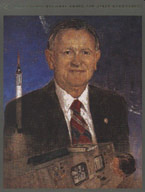
Portrait by Scott Medlock,
Scott Medlock Studio, California.
Christopher C. Kraft, a
driving force in the U.S. human spaceflight program from its beginning to the space shuttle era, was the recipient of the 1999
National Space Trophy. Born in Phoebus, Virginia, Kraft graduated from Virginia Polytechnic in 1944. He joined NASA's
predecessor at Langley Field in Virginia the next year and spent fourteen years testing aircraft. When NASA formed in '58, Dr.
Kraft was one of the 36 original members of the Space Task Group developing Project Mercury. He created the engineering and
operations organization that designed and controlled the first human missions. Kraft was the first Flight Director, and held
that position for all of Mercury, and the first seven flights of Gemini. He was Director of Flight Operations through Apollo 12,
and then became Deputy Director of what is now Johnson Space Center. He became Director in '71, playing a vital role in the
success of the final Apollo missions and the first Space Shuttle flights. He retired in 1982 and served as a consultant and board
member of various Houston companies, as director-at-large of the Houston Chamber of Commerce, and as a member of the Board of
Visitors at Virginia Polytechnic Institute and State University. His book,
FLIGHT: My Life In Mission Control, was
published in 2001 and was a New York Times bestseller. See
1999 winner for a longer
profile.
Return to the top
1998 Winner: President George H.W. Bush
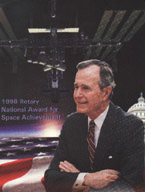
Design by Frances W. Jones,
Johnson Engineering.
Former President George H. W. Bush received the National Space Trophy in
1998 for leading a golden era of space science that included the Magellan mission to Venus, the Galileo mission to Jupiter, and
the Cosmic Background Explorer's study of the early Universe. President Bush was born in Milton, Massachusetts. The youngest Navy
pilot when he got his wings, he flew 58 combat missions in WWII. He got his degree from Yale in '48, and began his political
career as Chairman of the Harris County Texas Republican Party in '63. He was elected to Congress in 1966 and served two terms.
He held many senior positions in government in the 1970's including UN Ambassador and Director of the CIA. While Vice President
under Ronald Reagan, he visited Mission Control in Houston, and congratulated the STS-26 crew in California on returning the
shuttle to flight after the Challenger accident. As President from '89 to '93, he launched a new era in robotic exploration and
began an exchange of crews between the Russian
Mir and American Shuttle programs. On the 20
th anniversary of
Apollo 11's landing, President Bush proposed a return to the moon and a goal to land on Mars by 2019. President Bush left office
in '93 and settled in Houston. See
1998 winner for a longer profile.
Return to the top
1997 Winner: George W.S. Abbey
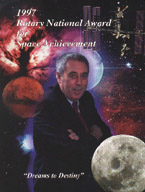
Photo by J. Pamela
Photography.
George W. S. Abbey, then director of Johnson Space Center, received the National Space Trophy in 1997 for his
dedication to the goals of space exploration. Born in Seattle, George Abbey graduated from the U.S. Naval Academy in 1954, and
earned a master's degree in engineering from the U.S. Air Force Institute of Technology in Ohio in '59. An Air Force pilot,
Captain Abbey was detailed to NASA's Apollo program in 1964. He left the Air Force in '67 and served as technical assistant to
the JSC Director, and earned the Medal of Freedom for his role in Apollo 13 operations. As Director of Flight Operations starting
in '76, George Abbey oversaw the early shuttle flights, and became Director of Flight Crew Operations in '83. From '88 to '94, he
worked at NASA Headquarters, and served as senior NASA representative to the Synthesis Group, and as Senior Director, Civil Space
Policy, for the National Space Council. He became Deputy Director of JSC in '94, and was selected Center Director in '96. During
this time, JSC became the lead center for shuttle and space station programs. Abbey became Senior Assistant for International
Issues in 2001, and retired in 2003. See
1997 winner for a longer profile.
Return to the top
1996 Winner: Robert L. Crippen
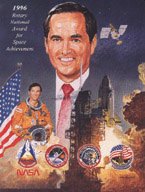
Painting by Maurice Lewis.
Astronaut Robert L. Crippen received the 1996 National Space Trophy for
his pivotal role in returning the shuttle to safe flight after the Challenger accident, and his leadership of both the space
shuttle program and Kennedy Space Center. From Beaumont, Texas, Crippen earned his degree in aerospace engineering from the
University of Texas in 1960. He was a Navy pilot, an instructor with the Air Force, and selected for the USAF Manned Orbiting
Laboratory Program. He became an astronaut in 1969, and worked on various programs while waiting 15 years to fly in space. He was
the pilot on the first space shuttle flight in 1981. In 1983, he commanded STS-7, the first flight of 5 people, including the
first American woman, Sally Ride. In 1984, he commanded STS 41-C that retrieved and repaired the Solar Max Satellite, and STS
41-G that included the first spacewalk by an American woman, Kathy Sullivan. Crippen became Space Shuttle director in 1990,
and Director of Kennedy Space Center in Florida in 1992. During his tenure, KSC launched 22 shuttle flights and 42 expendable
rockets. He left NASA in 1995, and became a Vice President with Lockheed Martin in Orlando, Florida. He joined Thiokol Propulsion
in Utah in 1996, and served as President until retiring in 2001. See
1996 winner for a
longer profile.
Return to the top
1995 Winner: Daniel S. Goldin
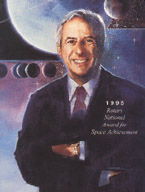
Painting by Alan
Chinchar.
Daniel S. Goldin, the who advocated a, "faster, better, cheaper" way of doing business, received
the 1995 National Space Trophy for his passionate leadership and fiscally responsible management of the space program. A native
of New York City, Goldin received his degree in mechanical engineering from the City College of New York. His first job was
with NASA at what is now the Glenn Research Center in Cleveland, Ohio. After 5 years, he went to work for TRW in California,
staying 25 years and rising to the position of Manager of the TRW Space & Technology Group. Daniel Goldin became NASA
Administrator in 1992, and launched a series of management reforms, saving the government billions of dollars. He initiated the
Discovery program to reduce the development time and mission cost of planetary probes, oversaw the redesign of the space station
to include a new partnership with the Russians, put together the team that repaired the Hubble Space Telescope, and saw the
shuttle program through its 20
th anniversary. Goldin left NASA in 2001. See
1995
winner for a longer profile.
Return to the top
1994 Winner: Edward C.Aldridge
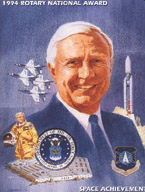
Portrait by Edward Diffenderfer.
Edward C.Aldridge was the recipient of the 1994
National Space Trophy for his foresight and persuasive leadership on critical space policy issues. Aldridge was born in
Houston, Texas. He got his engineering degree from Texas A&M in 1960, and his masters from Georgia Tech in '62. He began his
career with Douglas Aircraft in California then joined the Department of Defense in 1967. He remained with the DoD except for a
few years in the '70's. In 1985, he trained as a payload specialist, but his flight was cancelled after the Challenger accident
in 1986. Soon afterwards, President Reagan appointed Aldridge Secretary of the Air Force, where he initiated the mixed fleet
strategy of using the shuttle and expendable vehicles. From 1988 to '92, he was President of McDonnell Douglas. In '92 he became
CEO of The Aerospace Corporation, the position he held when he received the Rotary award and until 2001, when he was named Under
Secretary of Defense for Acquisition, Technology and Logistics. He joined the Board of Lockheed Martin in 2003. In 2004, he led
the commission charged with visualizing President's Bush's space policy. See
1994 winner
for a longer profile.
Return to the top
1993 Winner: Thomas P. Stafford
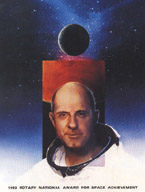
Portrait by Alan Chinchar.
Lieutenant Thomas P. Stafford, USAF (retired) was the
1993 recipient of the National Space Trophy for his contributions as an astronaut, administrator, and space advisor over a span
of three decades. Stafford was born in Weatherford, Oklahoma. He graduated from the U.S. Naval Academy in 1952 and was an
Air Force fighter and test pilot. He joined NASA as an astronaut in 1962. He was the pilot for Gemini 6 in 1965, and the
commander for Gemini 9 the next year, both important rendezvous missions. Stafford commanded Apollo 10, the dress
rehearsal for the first moon landing in 1969. After that flight, he became head of the astronaut office. He commanded the
historic first Russian/American Apollo-Soyuz mission in 1975. He left NASA later that year to command the Air Force Flight Test
Center, and in '78 became Deputy Chief of Staff, Research Development and Acquisition, at Air Force Headquarters in D.C. He
retired in 1979, and co-founded the technical consulting firm of Stafford, Burke, and Hecker in Alexandria, Virginia. In 1990,
Stafford chaired a team to advise NASA on how to carry out President Bush's vision of returning to the Moon and exploring
Mars. Their report, "America at the Threshold", influenced the course of the space program throughout the 1990's. See
1993 winner for a longer profile.
Return to the top
1992 Winner: Norman R. Augustine
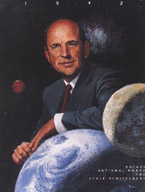
Portrait by John Solie.
Norman R. Augustine received the 1992 National Space Trophy for his work as
a guiding force in our nation's exploration of space. He served as Chairman of the presidential advisory committee on the Future
of the United States Space Program that delivered its landmark report in December 1990. Augustine was born in Denver,
Colorado. He earned his degree in Aerospace Engineering in 1957, and his Masters in 1959, both from Princeton. Starting as Chief
Engineer in 1958 with Douglas Aircraft Company, Augustine moved to the Defense Department in 1965 as Assistant Director of
Defense Research and Engineering. In 1970, he returned to the private sector with LTV Missiles and Space Company. He re-joined
the government in 1973 as the Assistant Secretary of the Army, and became Under Secretary of the Army in 1975. Augustine
joined Martin Marietta in 1977, rising to CEO and Chairman. When the company merged with Lockheed in 1995, he was named
President, then CEO, and later Chairman of the Board of Lockheed Martin. He retired in 1997, and served as an engineering
Professor at Princeton until 1999. The author of numerous books on management, including the popular
Augustine's Laws, he
received the Medal of Technology from the President of the United States in 1998. See
1992
winner for a longer profile.
Return to the top
1991 Winner: Aaron Cohen
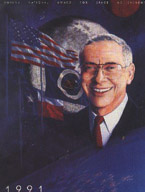
Portrait by Pat Rawlings/SAIC.
The 1991 recipient of the National Space Trophy was Aaron Cohen, then serving as the director of Johnson Space Center. Cohen was cited for his leadership in increasing America's capabilities in space through safer and more efficient operation of the space shuttle. From Corsicana, Texas, Cohen received his degree in Mechanical Engineering from Texas A&M in 1952, and his Master's degree in Applied Mathematics from Stevens Institute of Technology in 1958. After serving in the Army, Cohen joined NASA in 1962 and played a key role in the success of all Apollo missions. From 1972 to 1982, he was manager of the Space Shuttle orbiter project, directing the orbiter's design, development, production, and first test flights. He served as Director of Research and Engineering and became JSC Center Director in 1986, after the Challenger disaster. Under his leadership, the shuttle returned safely to flight in 1988. Cohen was called to Washington, DC as Acting NASA Deputy Administrator in 1992, and then returned to JSC before retiring in 1993. Cohen served as the Zachry Professor of Engineering at Texas A&M until 2001. He served on the RNASA Stellar Ranking Committee from 1997 - 2007, and on the Board of Advisors from 1987 until his death in February 2010. See
1991 winner for a longer profile.
Return to the top
1990 Winner: Lew Allen
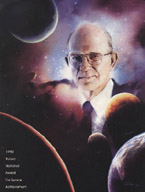
Painting by Alan Chinchar.
Lew
Allen (1925-2010) received the National Space Trophy in 1990 for rekindling the public's interest in the solar system by
overseeing, as Director of the Jet Propulsion Lab in California, a series of spectacular unmanned missions to the outer planets.
Allen was born in Miami, Florida, graduated from West Point in 1946, and served in the Strategic Air Command's 7th
Bombardment Group at Carswell Air Force Base. He received masters and doctorate degrees in physics from the University of
Illinois in 1952 and '54. He rose to the rank of in the Air Force, eventually becoming the Air Force Chief of Staff and
member of the Joint Chiefs of Staff. Allen retired from the Air Force and became the director of JPL and vice president
of the California Institute of Technology in 1982. There, he oversaw the teams responsible for the Magellan Venus radar mapper,
the Galileo mission to Jupiter, the Voyager 1 flybys of Jupiter and Saturn, and the Voyager 2 flybys of Jupiter, Saturn, Uranus
and Neptune. Voyager 1 is the most distant manmade object and carries a gold record 'greeting to the universe' reflecting life
and culture on Earth. Allen left JPL in 1990, and served as Chairman of the Board of the Charles Stark Draper Lab in Boston,
Massachusetts. Allen served on the RNASA Foundation Board of Advisors from 1989 until his death. He died on January 4, 2010,
at his home in Potomac Falls, Virginia. See
1990 winner for a longer profile.
Return to the top
1989 Winner: Richard H. Truly
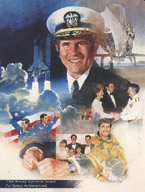
Painting by Rick Johnson.
The 1989 recipient of the National Space Trophy was US Navy Rear Admiral
Richard H. Truly for his 20 years of distinguished contributions to the space program, first as an astronaut, and then as an
administrator. Admiral Truly was born in Fayette, Mississippi, and earned his engineering degree from Georgia Tech in 1959. As a
Naval aviator, he made more than 300 carrier landings and then became an instructor at the Air Force Research Pilot School at
Edwards Air Force Base in California. In 1965, he was selected as a military astronaut and became a NASA astronaut in 1969. He
worked as a Capcom for all 3 Skylab flights in 1973 and the Apollo Soyuz mission in 1975. He was the pilot for the approach and
landing test of the Space Shuttle Enterprise in 1977, and of Columbia on STS-2 in 1981, the first reflight of a spacecraft. He
was the commander of the Space Shuttle Challenger for the STS-8 mission that made the first night launch and landing in 1983.
Admiral Truly left NASA that year to be commander of the Naval Space Command in Dahlgren, Virginia. A month after the Space
Shuttle Challenger accident in 1986, Admiral Truly returned to NASA as Administrator and oversaw the successful return to flight.
He left NASA in 1992 to be Director of the Georgia Tech Research Institute in Atlanta, Georgia. See
1989 winner for a longer profile.
Return to the top
1988 Winner: Don Fuqua
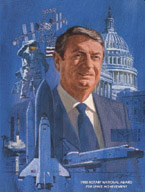
Painting by Edward Diffenderfer.
The second recipient of the National Space Trophy was the Honorable Don Fuqua, a Florida Congressman who was one of the
leading architects of the governmental framework upon which the world's greatest space program was built. Fuqua served in the
Army for two years, and then earned his degree in agricultural economics from the University of Florida. He was elected to
Congress in 1963, and gained firsthand knowledge of the U.S. Space program as a member, and then Chairman (from 1971-1981) of the
Subcommittee on Space Science and Applications. This subcommittee played an important role in aiding President Kennedy's
commitment to land men on the moon. Congressman Fuqua became Chairman of the full House Science and Technology Committee in 1979,
and through his leadership, insured that vital technical programs were adequately funded. During his 12 terms in Congress, Mr.
Fuqua oversaw most of the nation's civilian research and development programs. From 1987 to 1998, he was the President of the
Aerospace Industries Association and served as a leading spokesman for the U.S. space industry. See
1988 winner for a longer profile.
Return to the top
1987 Winner: Maxime A. Faget
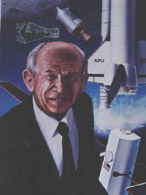
Portrait by Pat Rawlings/SAIC.
The first recipient of the National Space Trophy was Maxime A.
Faget, the chief designer and engineering genius of Project Mercury, the first American manned spacecraft. Faget was born in
British Honduras, graduated from Louisiana State University, and served as an officer in the Navy submarine service during WWII.
After the war, he joined the National Advisory Committee for Aeronautics, the predecessor to NASA, at Langley Aeronautical Lab on
Wallops Island, Virginia. At NACA, he worked on the design of the X-15, the first manned vehicle to reach Mach 6 and an altitude
of over fifty miles. Faget was one of the original 35 members of the Space Task Group that founded the NASA Johnson Space
Center in Houston, Texas. He was the chief designer of the Mercury, Gemini, and Apollo Command Module spacecraft. Faget is
often called the father of the space shuttle because his study of reusable spacecraft led to the decision to develop that
vehicle. Faget retired in 1981 after a 35-year career that many credit with the success of the American space program. He
passed away October 9, 2004 at his home in Houston at the age of 83. See
1987 winner for
a longer profile.
Return to the top





































